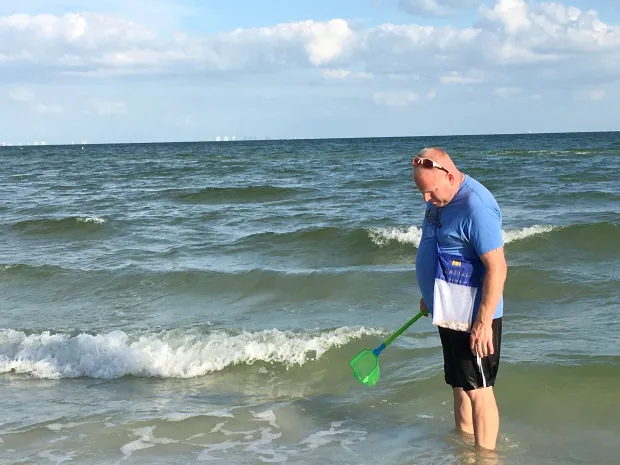Cenotes, sacred to the Mayans, treat Yucatan visitors to cool dips, glimpses into ancient cultures
Mexican peninsula home to 6,000 freshwater-filled sinkholes

Visitors reaching a cenote by stairs prepare to join others in the cool, clean 75- degree water. (Janet Podolak)
There’s hardly a better way to spend a hot day than swimming in a cenote on Mexico’s Yucatan peninsula.
The cool, fresh, 75-degree cenote water is delightful now, when temperatures are in the 80s, and even better when spring and summer days reach 100 or more.
With 6,000 of these freshwater-filled sinkholes on the Yucatan peninsula, you’ll find one to suit every age and expertise in the water. Many are within an hour’s drive of Merida, where I spent a week in November.
According to Mayan mythology, the complex system of underground rivers was formed millions of years ago when an asteroid they call Chicxulub hit the earth to form the Gulf of Mexico. Cenotes resulted when the heavy root systems of trees on the surface broke through to create sinkholes to the underground waters.
The complex river system is not yet fully understood or explored, but those interested in the science behind it can learn more with a visit to a webpage from Northwestern University.
It’s possible to both dive and swim in cenotes, with a wide variety of types near Merida. Some are easy to reach down wide staircases cut into the surrounding limestone, while others are accessed by boats or horsedrawn carts. Wilder cenotes can be reached by rappelling or diving into them and should be explored only by an accomplished swimmer accompanied by a guide.
Xlacah is on a Mayan archeological site, while Dzul-Ha can be visited as part of a tour to Hacienda Sotuta de Peon, one of the restored haciendas established in the 1600s by the Spanish conquerors of the area.
Many of the cenotes are operated much as water parks, with hot showers, locker rooms, snorkel rentals, ziplines and restaurants on the grounds for visitors.
Multilingual interpretation of Mayan lore and history is part of the experience. Believed to be entries to the underworld — as well as reliable sources of water, especially important during times of drought — cenotes were and are sacred to the Mayan people. Sunscreen and insect repellent are prohibited to preserve the pristine water and the creatures living in it. Expect stalactites and stalagmites when you visit cenotes, as they are part of a system of caverns.
The Mayans are alive, well and very much a part of life in and around Merida, which is Yucatan’s capital and largest city with a population close to 1 million. Visit Merida’s centrally located Catedral de San Ildefonso and find Mayan glyphs etched on the building’s stones. That’s because the stones came from early Mayan structures already in place when Francisco de Montejo founded Merida in 1542.
Today’s Mayan speakers number about half of Yucatan’s population, although most live in communities of thatched huts and, like the Amish, preserve and cherish their own culture without wishing to share it.

This Mayan hut is typical of one-room dwellings with thatched roofs and without electricity. (Janet Podolak)
A few Mayan villages are open by reservation for interested tourists. Many Mayans do not speak Spanish, and certainly not English, so visiting via an organized tour is best.
Ancient Mayans, known for their advances in astronomy, math and medicine, were enslaved by the Spanish conquistadors and used as labor in the growing henequen industry, in which fiber and rope were made into sisal from agave cactus. The sisal made descendants of the Spanish wealthy and led to economic prosperity, except for the Mayans. They revolted, and the War of the Castes continued from 1847 to 1901, but it took until 1915 for Mayan independence to be declared.

ATVs were used to travel Yucatan’s backcountry to visit a thatched-roof Mayan village. (Janet Podolak)
Reaching Mayan villages by ATV in the countryside, we found people living without electricity and running water in thatched-roof huts, where they cooked underground and prepared our meal over open fires in ways little changed for centuries. Black beans, pork, corn and tacos are basics of the Mayan (and Mexican) diet.
Mayan women typically wear beautifully embroidered dresses and create embroidered pieces to sell. Men often make and sell hammocks.

Wearing a hand-embroidered dress, a Mayan woman embroiders pieces to sell to visitors. (Janet Podolak)
Some are employed to do piecework for those making guayaberas, the typical men’s shirt from the region. Designed to be worn untucked, it is cool, looks fashionable and makes a great gift to bring home. A handcrafted hammock is another great souvenir.






Recent Comments